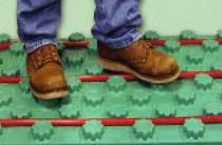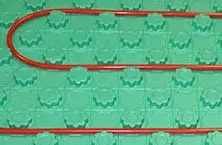Crete-Heat® FAQ
How can I save labor by using Crete-Heat® panels?
In the short run, you can save labor hours by using the unique knobs or flowers to grab and hold your PERT, PEX. The panel's design allows installers to keep their spacing consistent. If the installers don't like the layout, simply pull up the PERT, PEX, and start over. In the long run, "walking" the PERT, PEX into place can save up to 75% of hand and knee "tie off" time and the ergonomic problems that can follow.
What are the advantages of using Crete-Heat® panels?
Ease of use: labor savings; energy savings; environmentally friendly; faster construction; few design limitations; won’t support mold growth; provides no food source for termites or other pests.
How do I cut Crete-Heat® panels?
Any utility knife or drywall saw would work, or the panels can be scored and snapped.
How can I prevent PERT, PEX ‘pop’ in cold weather?
PERT, PEX tubing can be a challenge to unwind and bend in cold weather regardless of how it is being installed. Try to keep the PERT, PEX warm before and during installation to minimize the possibility of kinks and backlash. If your PERT, PEX wants to" pop" in a bend, it may be necessary to use an occasional plastic staple or half clamp to fasten the PERT, PEX to the Crete-Heat™ panel.
What about “R” value ratings?
The "R" value controversy is as confusing as the IRS tax code, and many insulation vendors like it that way. While there is a lot of difference between lab testing and real-life, thermodynamics is what it is, regardless of what is published on a vendor's line card. In" slab on grade" hydronic installations, you need a thermal break under the tubing to keep the heat in the slab and prevent heat from escaping to the ground underneath. More "R" means less heat loss, but more material cost. Crete-Heat® panels have an "R" value of 10 for the two-inch and 6 for the one-inch.
How much is the "R" value correct for my project?
Consult with your radiant designer for your project. Factors such as climate, water table, and occupancy, among others, will influence the "R" value desirable and economically justifiable. In many cases, Crete-Heat® panels have sufficient "R" value to be placed directly on the leveled sub base.
What is the purpose of the plastic skin over the panels?
Crete-Heat® panels have skin to provide the toughness required to withstand the rigors of the jobsite. It also provides an adequate vapor retarder. If you anticipate heavy traffic before the pour, we advise protecting the panels with plywood sheeting. Repeated removal and replacement of PERT, PEX may hamper the ability of the panels to continue to grip tubing.
Does the color of the plastic skin mean anything?
Plastic film color has no effect on the properties of the panel. It only serves as a reminder to build "Green."
Are Crete-Heat® panels flammable?
Because they are treated with a fire retardant, exposed Crete-Heat® panels will self-extinguish once a source of flame is removed. After installation, the concrete pour will act as a barrier, and the foam panels should not contribute to a fire.
Do Crete-Heat® panels act as a vapor barrier?
Yes, when properly installed.
Will Crete-Heat® panels harbor mold?
ASTM C1338 (Standard Test Method for Determining Fungi Resistance of Insulation Materials and Facings) testing done on expanded polystyrene has demonstrated that under laboratory conditions, there was no trace of growth over a 28 day incubation period. This test was done for five types of fungal growth.
Can Crete-Heat® panels be used for outdoor applications?
The best outdoor use for Crete-Heat® panels is snowmelt on concrete sidewalks, driveways, or handicapped ramps.
Can Crete-Heat® panels be used on a second story?
Yes, but only if the building structure will support the weight of the concrete or lightweight concrete. Another consideration is the additional height of the combined thickness (usually 3” to 4”) of the panels and concrete.
Will the panels crush under the concrete?
Crete-Heat® panels have a compressive strength of 25 psi / 3600 psf.
Why is a concrete or lightweight concrete over-pour necessary?
Crete-Heat® panels are designed for use with the thermal mass “flywheel” effect of concrete. A heated mass tends to radiate warmth long after the heat source is removed, providing the most comfortable heat imaginable. Also, hydronic radiant heat is very economical because it heats the thermal mass instead of the air.
How do I know how many Crete-Heat® panels I need?
To estimate the square feet of panels needed for a job, simply take the square footage and divide it by 8. This is the number of panels needed. Crete-Heat® panels are sold only in full bags. For example, if your project is 25,000 sq. ft./ 8 = 3125 panels, divide by 8 again = 390.625 bags. We would ship 391 bags, and you would have a few left for miss-cuts, odd cuts, and samples.
Why do I need to level the sub base before installing Crete-Heat® panels?
Good workmanship always pays dividends, and this is no exception. The panels will lay flatter with less chance of breakage if you can keep the high and low spots within a 1" of each other. You will have less panel damage and a more even pour. Your customer will be happier because the result will be a more even heat distribution.
What about wire mesh?
If wire mesh is being used on the Installation Crete-Heat, ® panels will still hold the PERT, PEX on the base, and not be tied to the mesh. This eliminates concerns about the PERT, PEX "floating" near the surface during the pour.
Are Crete-Heat® panels code approved?
Yes, See Specification Page.
Are Crete-Heat® panels recyclable?
Crete-Heat® panels can be reprocessed into the basic polystyrene resin they are derived from.


